Less predictable rainfall important for Maya decline
Reduced predictability of seasonal rainfall might have played an important role in the disintegration of Classic Maya societies about 1100 years ago. That is the result of a new study of the Potsdam Institute for Climate Impact Research (PIK) and Potsdam University. The research team studied variations in stable isotope signatures from a stalagmite that was collected in a cave near Uxbenka/Belize, an important archaeological site in the former heartland of the Maya. The carbon and oxygen isotope ratios are sensitive recorders of local and regional rainfall dynamics.
“A key ingredient for Maya agriculture was the timely arrival of sufficient rainfall. Farming in subtropical Central America is tough because freshwater is only available during the summer rainy season. Changes of onset and intensity of the rainy season can have serious repercussions for Central American societies”, explains Tobias Braun from PIK, lead-author of the study published in Communications Earth & Environment. While most scientists agree that repeated intense droughts were one of the key factors that led to the fragmentation of urban centers and redistribution of lowland Maya societies, evidence at seasonal time scale was so far missing. And this is exactly what the study takes into focus. “With a versatile method called ‘Recurrence Analysis’, we found that reduced seasonal predictability, in combination with severe droughts might have acted as a catalyzer for institutional destabilization and fragmentation of Maya societies,” Braun adds.
In the study region, the arrival of summer rains depends to a great extent on the so-called Intertropical Convergence Zone (ITCZ), a band of convergence between the northeast and southeast trade winds, which occasionally changes its position but also its width and regional strength. The observed changes in seasonal rainfall could have been caused by a less consistent ITCZ, which made it difficult for the Maya to predict seasonal rain from one year to the next.
“Being unable to secure sufficient crop yields, might have sparked social unrest in urban centers and, in turn, resulted in complex processes of sociopolitical disintegration that ultimately led Maya societies to return to more decentralized, less dense populated agrarian villages,” says Norbert Marwan from PIK, also author of the study. “Despotic Maya leaders were heavily invested in accumulating wealth and costly ceremonies, and likely far less interested in resilient responses to environmental change.”
Some Maya societies were able to adapt, others were not. Maya populations in the northern lowlands persisted and built the Postclassic center of Mayapan. Southern lowland societies, however, failed to organize in new urban settlements.
Article: Tobias Braun, Sebastian F. M. Breitenbach, Vanessa Skiba, Franziska A. Lechleitner, Erin E. Ray, Lisa M. Baldini, Victor J. Polyak, James U. L. Baldini, Douglas J. Kennett, Keith M. Prufer & Norbert Marwan: “Decline in seasonal predictability potentially destabilized Classic Maya societies”. Nature Communications Earth & Environment.
Link to the article: https://www.nature.com/articles/s43247-023-00717-5
For further information please contact:
PIK press office
Phone: +49 331 288 25 07
E-Mail: press@pik-potsdam.de
www.pik-potsdam.de
Who we are: The Potsdam Institute for Climate Impact Research (PIK) is one of the leading research institutions addressing relevant questions in the fields of global change, climate impacts and sustainable development. Natural and social scientists work closely together to generate interdisciplinary insights that provide a sound basis for decision-making for society, businesses and politics. PIK is a member of the Leibniz Association.

 “Interglacial Narrows (Poems 1915-2021)” Contra Mundum Press
“Interglacial Narrows (Poems 1915-2021)” Contra Mundum Press “Always the Many, Never the One: Conversations In-between, with Florent Toniello” Contra Mundum Press
“Always the Many, Never the One: Conversations In-between, with Florent Toniello” Contra Mundum Press “Conversations in the Pyrenees”
“Conversations in the Pyrenees”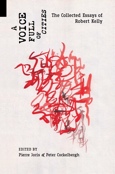 “A Voice Full of Cities: The Collected Essays of Robert Kelly.” Edited by Pierre Joris & Peter Cockelbergh
“A Voice Full of Cities: The Collected Essays of Robert Kelly.” Edited by Pierre Joris & Peter Cockelbergh “An American Suite” (Poems) —Inpatient Press
“An American Suite” (Poems) —Inpatient Press “Arabia (not so) Deserta” : Essays on Maghrebi & Mashreqi Writing & Culture
“Arabia (not so) Deserta” : Essays on Maghrebi & Mashreqi Writing & Culture “Barzakh” (Poems 2000-2012)
“Barzakh” (Poems 2000-2012) “Fox-trails, -tales & -trots”
“Fox-trails, -tales & -trots”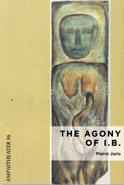 “The Agony of I.B.” — A play. Editions PHI & TNL 2016
“The Agony of I.B.” — A play. Editions PHI & TNL 2016 “The Book of U / Le livre des cormorans”
“The Book of U / Le livre des cormorans”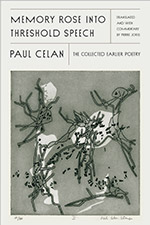 “Memory Rose Into Threshold Speech: The Collected Earlier Poetry of Paul Celan”
“Memory Rose Into Threshold Speech: The Collected Earlier Poetry of Paul Celan”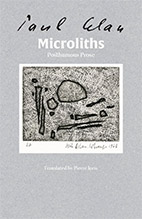 “Paul Celan, Microliths They Are, Little Stones”
“Paul Celan, Microliths They Are, Little Stones”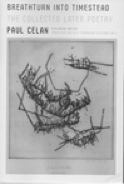 “Paul Celan: Breathturn into Timestead-The Collected Later Poetry.” Translated & with commentary by Pierre Joris. Farrar, Straus & Giroux
“Paul Celan: Breathturn into Timestead-The Collected Later Poetry.” Translated & with commentary by Pierre Joris. Farrar, Straus & Giroux